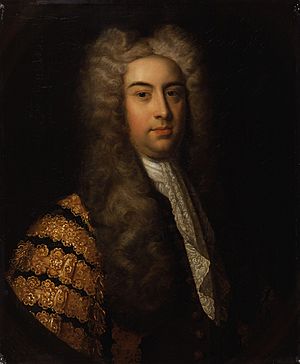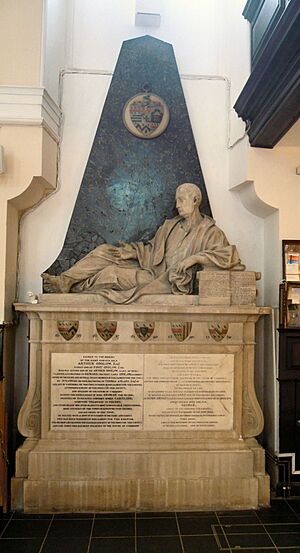Arthur Onslow facts for kids
Quick facts for kids
Arthur Onslow
|
|
|---|---|
 |
|
| Speaker of the House of Commons of Great Britain |
|
| In office 23 January 1728 – 18 March 1761 |
|
| Preceded by | Sir Spencer Compton |
| Succeeded by | Sir John Cust |
| Personal details | |
| Born | 1 October 1691 |
| Died | 17 February 1768 (aged 76) |
Arthur Onslow (born October 1, 1691 – died February 17, 1768) was an important English politician. He is famous for serving a very long time as the Speaker of the House of Commons. People knew him for being honest and fair.
Contents
Arthur Onslow's Early Life and Education
Arthur Onslow was born in Kensington. He was the older son of Foot Onslow and Susannah Anlaby. He went to The Royal Grammar School, Guildford, and Winchester College.
In 1708, he started at Wadham College, Oxford, but he didn't finish his degree. He became a barrister (a type of lawyer) in 1713. However, he didn't work much as a lawyer.
Arthur Onslow's Career Beginnings
When King George I became king, Arthur's uncle, Sir Richard Onslow, became the Chancellor of the Exchequer. This was a very important financial job. Arthur worked as his private secretary.
In 1715, when his uncle left that job, Arthur got a position as a receiver general for the Post Office. Later, in 1719, he became a Recorder (a type of judge) for Guildford.
Arthur's Post Office job meant he couldn't be a Member of Parliament. So, he gave the job to his younger brother, Richard. Arthur then entered Parliament in 1720, representing Guildford.
Arthur Onslow's Family Life
On October 8, 1720, Arthur Onslow married Anne Bridges. She was the daughter of John Bridges and niece of Henry Bridges. When Anne's father died, Arthur inherited a large estate. This greatly improved his financial situation.
Arthur and Anne made Imber Court in Thames Ditton their main home. They had two children:
- George Onslow, 1st Earl of Onslow (1731–1814)
- Anne Onslow (died 1751)
Arthur Onslow's Political Journey
In February 1720, Arthur Onslow became a Whig Member of Parliament for Guildford. He served there until 1727. During this time, he spoke out against a tax on Roman Catholics in 1722. He also opposed a move to clear Bolingbroke's name in 1725.
In 1726, he helped manage the trial of Macclesfield for corruption.
In 1727, he was elected for both Guildford and Surrey. He chose to serve for Surrey, and his brother Richard took his place in Guildford.
Becoming Speaker of the House of Commons
On January 23, 1728, Arthur Onslow was chosen to be the Speaker of the House of Commons. This was a very important role, and he was chosen by everyone. His uncle, Sir Richard Onslow, and an ancestor, Richard Onslow, had also been Speaker.
Arthur Onslow was re-elected Speaker four more times: in 1735, 1741, 1747, and 1754. He served for 33 years, which was a record for the longest time as Speaker.
On July 25, 1728, he joined the Privy Council. This is a group of important advisors to the King. He also became a bencher (a senior member) of the Middle Temple that year. In 1729, he became Chancellor to Queen Caroline.
Protecting Important Books
In October 1731, the Cotton Library caught fire. This library held many valuable old books and manuscripts. Arthur Onslow rushed to help that night. He threw books out of windows to save them from the flames. He then helped oversee their repair and preservation. Thanks to him, many important historical documents were saved for the country.
Onslow's Legacy as Speaker
Arthur Onslow was known for his great honesty as Speaker. This was a time when many politicians were not always fair. His biggest achievement was making the Speaker's job independent, powerful, and unbiased.
He still took part in some political activities, but he wasn't afraid to disagree with the government when needed. Onslow believed his role was to protect Parliament and its rules. He made sure parliamentary procedures were followed strictly. He thought this protected the rights of independent Members of Parliament.
On April 20, 1734, Onslow received the job of Treasurer of the Navy. This was a valuable position. In 1742, he gave up this job after voting on a political issue. He wanted to show that he was not influenced by his position.
He continued to earn money from his Speaker's role, especially from private bills. He also became the Recorder of Guildford and high steward of Kingston upon Thames in 1737.
In the 1730s, he helped create the Foundling Hospital, a home for abandoned children. He was one of its first governors. In 1753, he helped convince Parliament to buy the collections of Hans Sloane and the Harleian Library. These, along with the Cotton Library, helped create the British Museum.
Due to his health, he retired from Parliament in 1761. The House of Commons thanked him unanimously for his service. The King gave him a yearly payment of £3000 for his life and his son's life. This was the first time a retiring Speaker received a pension.
Arthur Onslow's Honours and Legacy
- Onslow was given the Freedom of the City of London.
- He was chosen as a trustee for the British Museum.
- Onslow County, North Carolina, in the United States, was named after him.
Arthur Onslow died in London in 1768. He was first buried in Thames Ditton. Later, his body and his wife's body were moved to the Onslow family burial place in Merrow Church, Surrey.
The writer Horace Walpole described Onslow as someone who was "too pompous to be loved, though too ridiculous to be hated." However, Walpole later wrote more thoughtfully:
No man had ever supported with more firmness the privileges of the House, nor sustained the dignity of his office with more authority. His knowledge of the constitution equalled his attachment to it. To the Crown he behaved with all the decorum of respect, without sacrificing his freedom of speech. Against the encroachments of the house of peers he was an inflexible champion. His disinterested virtue supported him through all his pretensions; and though to conciliate popular favour he affected an impartiality that by turns led him to the borders of insincerity and contradiction; and though he was often so minutely attached to forms, that it made him troublesome in affairs of higher moment, it will be difficult to find a subject, whom gravity will so well become, whose knowledge will be so useful and so accurate, and whose fidelity to his trust will prove so unshaken.
Arthur Onslow's Descendants
Speaker Onslow's nephew, George Onslow (1731–1792), was a lieutenant colonel and a Member of Parliament for Guildford. He served from 1760 to 1784. George had a younger brother, Richard (1741–1817), who joined the Royal Navy and became an Admiral in 1799.
One of Arthur Onslow's later descendants, Cranley Onslow, was also a Member of Parliament in the late 20th century.
Arthur Onslow in Thames Ditton
Arthur Onslow gained a lot from his marriage to Anne. He made Imber Court in Thames Ditton his main home. Early in his career, Onslow became High Steward of Kingston upon Thames. When he died in 1768, at age 76, he was buried at St Nicholas Church, Thames Ditton. Later, his body and his wife Anne's body were moved to the Onslow burial site at Merrow Church, near Clandon.


